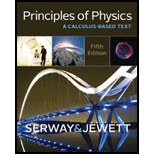
Concept explainers
(a)
The scattering angle of the photon and the electron.
(a)
Answer to Problem 18P
The scattering angle of the photon and the electron is
Explanation of Solution
The momentum of the photon before scattering is given by,
Here,
The momentum after scattering is given by,
The conservation of momentum in the
Here,
Use equation (II) and (I) in equation (III),
The conservation of momentum in the
Neglecting the trivial solution will gives,
Use equation (VI) in equation (IV),and solve for
X rays striking a target are scattered at various angles by electrons in the target. A shift in wavelength is observed for the scattered x rays and the phenomenon is known as the Compton effect.
Write the expression for the Compton effect.
Use equation (VII) in equation (VIII),
Solve equation (IX) for
Conclusion:
Solve equation (IX) for
Therefore, the scattering angle of the photon and the electron is
(b)
The energy and the momentum of the scattered photon.
(b)
Answer to Problem 18P
The energy and the momentum of the scattered photon is
Explanation of Solution
Write the expression for the energy of the scattered photon.
Write the expression for the momentum after scattering in terms of energy.
Use equation (VII) in equation (XII),
Conclusion:
Use equation (X) in equation (XIII),
Use equation (XIV) in equation (XII),
Therefore, The energy and the momentum of the scattered photon is
(c)
Kinetic energy and momentum of the scattered electron.
(c)
Answer to Problem 18P
Kinetic energy and momentum of the scattered electron is
Explanation of Solution
Write the expression for the kinetic energy of the electron according to the energy conservation.
Here,
Use equation (XIV) in equation (XVI),
Solve the above equation,
Conclusion:
Use equation (XV) in equation (XVII) to find
Therefore, Kinetic energy and momentum of the scattered electron is
Want to see more full solutions like this?
Chapter 28 Solutions
Principles of Physics
- A 0.75-nm photon is scattered by a stationary electron. The speed of the electron’s recoil is 1.5106 m/s. (a) Find the wavelength shift of the photon. (b) Find the scattering angle of the photon.arrow_forwardA 600-nm light falls on a photoelectric surface and electrons with the maximum kinetic energy of 0.17 eV are emitted. Determine (a) the work function and (b) the cutoff frequency of the surface. (c) What is the stopping potential when the surface is illuminated with light of wavelength 400 nm?arrow_forwardIf the work function of a metal is 3.2 eV, what is the maximum wavelength that a photon can have to eject a photoelectron from this metal surface?arrow_forward
- What is the maximum kinetic energy of photoelectrons ejected from sodium by the incident radiation of wavelength 450 nm?arrow_forwardThe work function for titanium is 4.33 eV. (a) Convert the value of the work function from electron volts to joules. J(b) Find the cutoff frequency for titanium. Hz(c) What maximum wavelength of light incident on titanium releases photoelectrons from the titanium's surface? nm(d) If light of energy 8.32 eV is incident on titanium, what is the maximum kinetic energy of the ejected photoelectrons? Give the answer in electron volts. eV(e) For photons of energy 8.32 eV, what stopping potential would be required to arrest the current of photoelectrons? Varrow_forwardThe work function for nickel is 5.15 eV. (a) Convert the value of the work function from electron volts to joules. J(b) Find the cutoff frequency for nickel. Hz(c) What maximum wavelength of light incident on nickel releases photoelectrons from the nickel's surface? nm(d) If light of energy 8.68 eV is incident on nickel, what is the maximum kinetic energy of the ejected photoelectrons? Give the answer in electron volts. eV(e) For photons of energy 8.68 eV, what stopping potential would be required to arrest the current of photoelectrons? Varrow_forward
- photons of energy 4.21 eV are incident on sodium, what is the maximum kinetic energy of the ejected photoelectrons? The work function for sodium is 2.46 eV. Group of answer choices 0.744 eV 1.17 eV 1.75 eV 0.275 eVarrow_forwardThe work function for gold is 5.10 eV. (a) Convert the value of the work function from electron volts to joules. J(b) Find the cutoff frequency for gold. Hz(c) What maximum wavelength of light incident on gold releases photoelectrons from the gold's surface? nm(d) If light of energy 7.42 eV is incident on gold, what is the maximum kinetic energy of the ejected photoelectrons? Give the answer in electron volts. eV(e) For photons of energy 7.42 eV, what stopping potential would be required to arrest the current of photoelectrons? Varrow_forwardA 0.00220-nm photon scatters from a free electron. For what (photon) scattering angle does the recoiling electron have kinetic energy equal to the energy of the scattered photon?answer in degrees °arrow_forward
- A light beam of wavelength 460 nm and intensity 180 W/m^2 shines on a target of area 1.69 m^2 for a duration of 4.25 s. How many photons from the light beam will have struck the target during this time?arrow_forwardPhoton P shown moves an electron from energy level n = 1 to energy level n = 3. The electron jumps down to n = 2, emitting photon Q, and then jumpsdown to n = 1, emitting photon R. The spacing between energy levels is drawn to scale. What is the correct relationship among the wavelengths of the photons?A. λP < λQ < λR B. λR < λP < λQC. λQ < λP < λR D. λR < λQ < λParrow_forward
 Principles of Physics: A Calculus-Based TextPhysicsISBN:9781133104261Author:Raymond A. Serway, John W. JewettPublisher:Cengage Learning
Principles of Physics: A Calculus-Based TextPhysicsISBN:9781133104261Author:Raymond A. Serway, John W. JewettPublisher:Cengage Learning Physics for Scientists and Engineers with Modern ...PhysicsISBN:9781337553292Author:Raymond A. Serway, John W. JewettPublisher:Cengage Learning
Physics for Scientists and Engineers with Modern ...PhysicsISBN:9781337553292Author:Raymond A. Serway, John W. JewettPublisher:Cengage Learning Modern PhysicsPhysicsISBN:9781111794378Author:Raymond A. Serway, Clement J. Moses, Curt A. MoyerPublisher:Cengage Learning
Modern PhysicsPhysicsISBN:9781111794378Author:Raymond A. Serway, Clement J. Moses, Curt A. MoyerPublisher:Cengage Learning University Physics Volume 3PhysicsISBN:9781938168185Author:William Moebs, Jeff SannyPublisher:OpenStax
University Physics Volume 3PhysicsISBN:9781938168185Author:William Moebs, Jeff SannyPublisher:OpenStax



